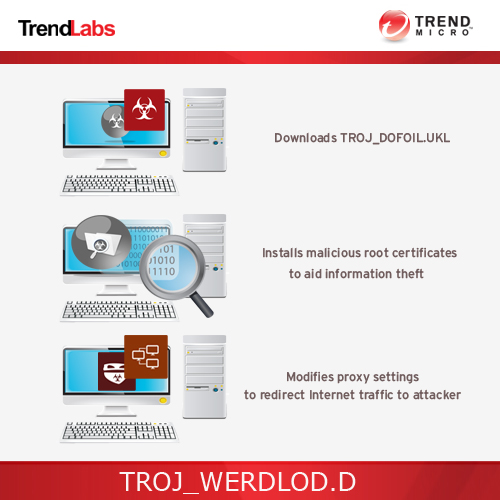TROJ_WERDLOD.D
PWS:Win32/Zbot (Microsoft); Backdoor.Win32.Androm.ghcb (Kaspersky)
Windows


Threat Type: Trojan
Destructiveness: No
Encrypted:
In the wild: Yes
OVERVIEW
This online banking Trojan modifies an affected system's proxy settings and adds a malicious root certificate to allow information theft at the network level. These behaviors are seen in malware used in Operation Emmental.
To get a one-glance comprehensive view of the behavior of this Trojan, refer to the Threat Diagram shown below.

This Trojan arrives on a system as a file dropped by other malware or as a file downloaded unknowingly by users when visiting malicious sites.
It does not have any propagation routine.
It does not have any backdoor routine.
As of this writing, the said sites are inaccessible.
TECHNICAL DETAILS
Arrival Details
This Trojan arrives on a system as a file dropped by other malware or as a file downloaded unknowingly by users when visiting malicious sites.
Installation
This Trojan drops the following file(s)/component(s):
- %All Users Profile%\cert{value}.der - install certificate on trusted root certificate store, will be deleted after
- %User Temp%\{random filename}.txt ← saves gathered cookies content
(Note: %All Users Profile% is the All Users folder, where it usually is C:\Documents and Settings\All Users on Windows 2000, Windows Server 2003, and Windows XP (32- and 64-bit); C:\ProgramData on Windows Vista (32- and 64-bit), Windows 7 (32- and 64-bit), Windows 8 (32- and 64-bit), Windows 8.1 (32- and 64-bit), Windows Server 2008, and Windows Server 2012.. %User Temp% is the user's temporary folder, where it usually is C:\Documents and Settings\{user name}\Local Settings\Temp on Windows 2000, Windows Server 2003, and Windows XP (32- and 64-bit); C:\Users\{user name}\AppData\Local\Temp on Windows Vista (32- and 64-bit), Windows 7 (32- and 64-bit), Windows 8 (32- and 64-bit), Windows 8.1 (32- and 64-bit), Windows Server 2008, and Windows Server 2012.)
Other System Modifications
This Trojan modifies the following file(s):
- {firefox path}\prefs.js
It adds the following registry entries:
HKEY_CURRENT_USER\Software\Microsoft\
Windows\CurrentVersion\Internet Settings
AutoConfigURL = "http://{BLOCKED}.{BLOCKED}6.200.228:8080/proxy.pac"
Propagation
This Trojan does not have any propagation routine.
Backdoor Routine
This Trojan does not have any backdoor routine.
Download Routine
This Trojan connects to the following website(s) to download and execute a malicious file:
- http://{BLOCKED}bunko.org/wp/wp-content/themes/twentyfourteen/images/vrucimeirxeimurixeuri.exe
It saves the files it downloads using the following names:
- %All Users Profile%\Microsoft-KB{random}.exe ← detected as TROJ_DOFOIL.UKL
(Note: %All Users Profile% is the All Users folder, where it usually is C:\Documents and Settings\All Users on Windows 2000, Windows Server 2003, and Windows XP (32- and 64-bit); C:\ProgramData on Windows Vista (32- and 64-bit), Windows 7 (32- and 64-bit), Windows 8 (32- and 64-bit), Windows 8.1 (32- and 64-bit), Windows Server 2008, and Windows Server 2012.)
As of this writing, the said sites are inaccessible.
NOTES:
This Trojan downloads Windows PoweSshell installer and installs it if the said Windows component is not existing.
It connects to the following to update count hits:
- http://www.{BLOCKED}ycounter.com/counter.php?vtrtvrvtrtvertvr
- http://www.{BLOCKED}ycounter.com/counter.php?tcrcrcerererwbvbbrtdf
It checks for the following processes:
- VBoxService
- VBoxTray
- Proxifier
- prl_cc
- prl_tools
- vmusrvc
- vmsrvc
- vmtoolsd
It checks for specific list of domains in browser cookies and browser history. When accessing specific domains, users access the malicious SOCKS server using the file from the following:
- http://{BLOCKED}.{BLOCKED}6.200.228:8080/proxy.pac
The modified prefs.js contains the following:
- user_pref(network.proxy.type.2)
- user_pref(network.proxy.autoconfig_url http://{BLOCKED}.{BLOCKED}.200.228:8080/proxy.pac)
It terminates the following processes:
- chrome.exe
- firefox.exe
- iexplore.exe
It imports rogue root certificates to browsers Internet Explorer and Firefox.
SOLUTION
Step 1
Before doing any scans, Windows XP, Windows Vista, and Windows 7 users must disable System Restore to allow full scanning of their computers.
Step 2
Note that not all files, folders, and registry keys and entries are installed on your computer during this malware's/spyware's/grayware's execution. This may be due to incomplete installation or other operating system conditions. If you do not find the same files/folders/registry information, please proceed to the next step.
Step 3
Remove malware/grayware files dropped/downloaded by TROJ_WERDLOD.D. (Note: Please skip this step if the threats listed below have already been removed.)
Step 4
Delete this registry value
Important: Editing the Windows Registry incorrectly can lead to irreversible system malfunction. Please do this step only if you know how or you can ask assistance from your system administrator. Else, check this Microsoft article first before modifying your computer's registry.
- In HKEY_CURRENT_USER\Software\Microsoft\Windows\CurrentVersion\Internet Settings
- AutoConfigURL = "http://5.196.200.228:8080/proxy.pac"
- AutoConfigURL = "http://5.196.200.228:8080/proxy.pac"
Step 5
Search and delete these files
- %All Users Profile%\cert{value}.der
- %User Temp%\{random filename}.txt
Step 6
Scan your computer with your Trend Micro product to delete files detected as TROJ_WERDLOD.D. If the detected files have already been cleaned, deleted, or quarantined by your Trend Micro product, no further step is required. You may opt to simply delete the quarantined files. Please check this Knowledge Base page for more information.
Step 7
Restore this file from backup only Microsoft-related files will be restored. If this malware/grayware also deleted files related to programs that are not from Microsoft, please reinstall those programs on you computer again.
- {firefox path}\prefs.js
Did this description help? Tell us how we did.


